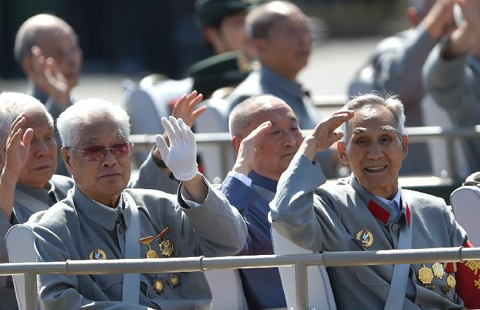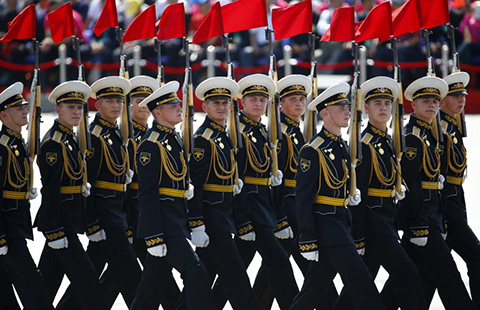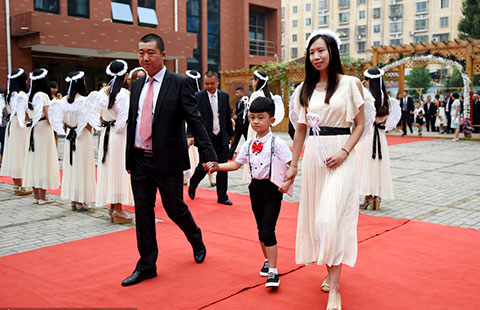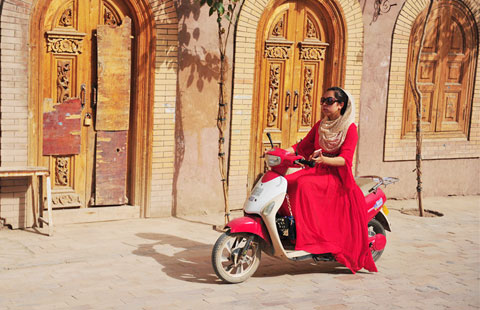Full Text: Successful Practice of Regional Ethnic Autonomy in Tibet
Updated: 2015-09-06 11:12
(Xinhua)
|
||||||||
I. Old Tibet: Dark and Backward
Even in the 1950s, Tibet was still a society ruled by feudal serfdom under theocracy. Having existed for several centuries, this wretched system stifled human rights and destroyed human qualities. It was thus the most backward mode of human society under which the people had no democratic, economic, social, or cultural rights, and their basic human rights were not protected. Old Tibet was a far cry from modern civilization.
Under feudal serfdom, serfs suffered cruel political oppression and had no personal freedom or fundamental rights.
Old Tibet implemented laws, as represented by the "16-Article Code" and "13-Article Code," that oppressed serfs. These laws divided people into three classes and nine ranks, whereby nobles, Living Buddhas and senior officials were born into and thus constituted the upper class, while the broad masses of serfs constituted the lower class. Value accorded to life correspondingly differed. The value of the life of a person of the upper class was measured in gold according to his weight. The value of the lives of butchers, blacksmiths, and others of the lowest rank of the lower class was equivalent to hempen rope. When people of different classes and ranks violated the same criminal law, the criteria in old Tibet for imposing penalties and the means of punishment were quite different. The laws stipulated that the punishment for a servant who injured his master was to have his hands or feet chopped off, but a master who injured a servant was not required to pay compensation. Serf owners and serfs had overtly unequal standing according to law. Serf owners held absolute power over the lives of serfs and slaves, and ensured their rule over the latter through savage punishments, including gouging out eyes, cutting out flesh or tongues, cutting off hands or feet, pulling out tendons, and being put in manacles.
The Kashag (cabinet) of old Tibet prescribed that all serfs must stay on the land within the manors of their owners. They were not allowed to leave without permission; fleeing the manor was forbidden. "All serfs have owners and all plots of land are assigned." Serfs were possessed by the three major estate-holders (local government officials, nobles and upper-ranking lamas in monasteries). They remained serfs from generation to generation, and confined to the land of their owners. All serfs and their livestock able to labor had to till the plots of land assigned to them and provide corvee labor. Once serfs lost their ability to labor, they were deprived of livestock, farm tools and land, and their status was degraded to that of slave. Since serfs were their private property, the three major estate-holders could use them as gambling stakes, mortgages for debt, present them as gifts, or transfer and trade them. All serfs needed permission from their owners to marry, and male and female serfs belonging to different owners had to pay "redemption fees" before such permission was granted. After marriage, serfs were also taxed on their newborn children, which were registered the moment they were born, so sealing their fate as lifelong serfs. Serfs that needed to make a living in other places were required to pay "servitudetax," and had to produce proof of having paid such tax or they would otherwise be punished as fugitives.
After presiding over the enthronement ceremony of the 14th Dalai Lama in 1940, Wu Zhongxin, chief of the Commission for Mongolian and Tibetan Affairs of the Kuomintang Government, described the rulers' oppression and the people's sufferings in old Tibet in his "Report on Tibetan Affairs on a Mission": "Located in frigid highlands, Tibet has rare agricultural products. The people live a hard life, whereas the Tibetan authorities do their utmost to oppress and exploit them, making the lives of the Tibetans one of hell and misery. The Tibetan authorities regard the people as slaves and beasts of burden and do not pay them as a rule; the people even have to find their own food and horse fodder; meanwhile they endure incessant, copious and complicated corvee labor and never enjoy days of peace. You can thus imagine how harassed they are. The authorities can issue an order to appropriate the people's property without compensation and bestow such property on lamaseries or meritorious nobles. In short, in Tibet, the people have lost their guarantee of survival and freedom, and their miserable life is beyond description."
Ruled by feudal serfdom under theocracy, serfs had no means of production, and their right to subsistence was under threat.
In old Tibet, the three major estate-holders and their agents accounted for only five percent of Tibet's population, but they owned almost all of Tibet's farmland, pastures, forests, mountains, rivers, and beaches, as well as most of the livestock. About 95 percent of old Tibet's population was made up of serfs, including "tralpa" as they are known in the Tibetan language (people who tilled plots of land assigned to them and who were obligated to provide corvee labor for serf owners), "duiqoin" (small households with chimneys emitting smoke), and "nangzan" (hereditary household slaves who were deprived of any means of production and personal freedom). They had no means of production and suffered cruel economic exploitation.
The first exploitation serfs suffered was land rent. Serf owners on feudal manors divided the land into two parts: The largest part was kept as manor demesne while smaller lots were rented to serfs under stringent conditions. To use the lots, serfs had to work on the demesne with their own farm implements and provide their own food. Such unpaid labor constituted the rent they paid to serf owners. Most of the grain that serfs harvested from the lots was finally taken away by estate-holders. A "tralpa" could only keep 100-150 kilograms of grain annually, which was not enough to live on; his diet mainly consisted of wild herbs and weeds mixed with a little grain. In addition to the heavy land rent paid in the form of labor, serfs had to pay numerous taxes and fees.
The second exploitation serfs suffered was corvee labor - a broad term covering not only corvee, but taxes and levies, and rents for land and livestock. The former local government of Tibet alone levied more than 200 kinds of taxes. Serfs had to contribute more than 50 percent or sometimes even 70 to 80 percent of their labor, unpaid, to the government and estate-holders. Corvee labor was divided into two kinds: one was that which serfs provided to the estate-holders they were bonded to and their agents; the other was the unpaid work serfs did for the local government of Tibet and its subordinates. The heaviest was transport corvee, because Tibet is large but sparsely populated and transport was inconvenient, necessitating the transport of all kinds of goods by humans or pack animals. Year after year, serfs were made to transport materials over mountains and rivers for the local government. This gave rise to the saying, "The boots have no soles, and the backs of the cattle are hairless."
The third exploitation serfs suffered was usury. In old Tibet, the three major estate-holders were all exploiters of usury. The local government of Tibet had many money-lending agencies, and lending money and collecting interest were among officials' duties. Many monasteries also participated in money-lending. Revenue from usury made up 25 to 30 percent of the total revenue of the three major monasteries, namely Drepung, Sera and Ganden. Most aristocrats were also engaged in usury, the interest of which accounted for 15 percent of their family revenues. Serfs had to borrow money to survive, and more than 90 percent of serf households were in debt. Serfs were burdened with new debts, debts passed down from previous generations, debts resulting from joint liability, and debts apportioned among all the serfs. One third of these were the debts passed down from previous generations which could never be repaid, even by succeeding generations, due to the imposition of compound interest.
Feudal serfdom under theocracy seriously obstructed social progress in Tibet. At the time of the peaceful liberation in 1951, there was almost no trace of modern industry, commerce, science and technology, education, culture, or health care. With no roads in the modern sense, Tibet was cut off from the outside world. Primitive farming had long been used in agricultural production, and farm tools were rudimentary. Herdsmen had to travel from place to place to find pasture for their livestock. There were few strains and breeds of grains and animals, and some had even degenerated. The level of both the productive forces and social development was thus extremely low.
French traveler Alexandra David-Neel described people's life in her book Le vieux Tibet Face a la Chine nouvelle (When Old Tibet Meets New China), "These poor people can only stay on their sterile land forever. They lose all human freedom, and become poorer and poorer each year." The people had no basic right to subsistence, much less to development. They were deprived of the right to education, and could not be schooled in their native language and culture. By the 1950s, the 2,000 or more studying in old-style government-run schools and old-style private schools were exclusively aristocrats; the illiteracy rate of the young and the middle-aged was 95 percent. The people had no right to economic development. The three major estate-holders squeezed profits from serfs, but did not update their tools; serfs worked day and night, but could not make more social products because they had no capability for social reproduction.
The feudal serfdom under theocracy in old Tibet was savage, cruel and backward, like the dark society of medieval Europe. In his book The Unveiling of Lhasa, British military journalist Edmund Candler, who visited Lhasa in 1904, recorded details of the old Tibetan society: "...at present, the people are medieval, not only in their system of government and their religion, their inquisition, their witchcraft, their incarnations, their ordeals by fire and boiling oil, but in every aspect of their daily life."

 Veterans attend V-Day anniversary gala show
Veterans attend V-Day anniversary gala show
 Military helicopters write number 70 high in the sky
Military helicopters write number 70 high in the sky
 Salute to veterans
Salute to veterans
 Xi attends the ceremony with other leaders
Xi attends the ceremony with other leaders
 Armored vehicles roll down the parade in huge roar
Armored vehicles roll down the parade in huge roar
 Foreign troops celebrate with Chinese comrades
Foreign troops celebrate with Chinese comrades
 Red carpet ceremony for first grade kids
Red carpet ceremony for first grade kids
 Kashgar old city in Xinjiang is well preserved
Kashgar old city in Xinjiang is well preserved
Most Viewed
Editor's Picks

|

|

|

|

|

|
Today's Top News
Sino-Russian investment fund eyes more deals
Predicting Internet's future without a crystal ball
Silk Road Fund to expand ties with lenders
Intl community echoes Xi's speech at V-Day commemoration
Envoy hails New York resolutions
Nation's military power grows but still trails behind
China to cut troops by 300,000: President Xi
Springfield gets Chinese railcar plant
US Weekly

|

|







